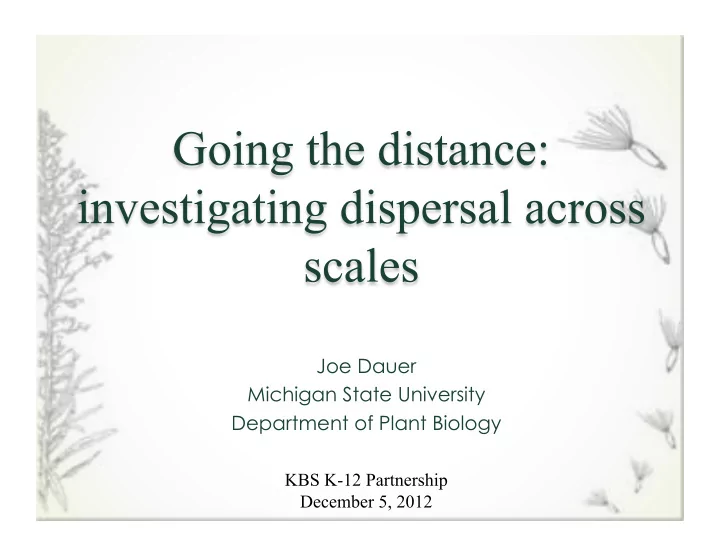

Joe Dauer Michigan State University Department of Plant Biology KBS K-12 Partnership December 5, 2012
• Long-distance seed dispersal in the atmosphere • Plant dispersal through soil • Kazoo experiential learning activities 2
Images of knotweed, ragwort, horseweed 3
Dispersal – the movement of organisms away from their source (Nathan 2001) o Superspreaders in epidemiology o Connectivity and corridors in restoration ecology and biodiversity o Management of species Why plant ecologists care about dispersal o Not a behavioral response, passively distributed o The major driver of plant invasions 4
Relocation Processes Source Processes Destination Processes Cessation of dispersal Adaptations to dispersal Likelihood of impact Initiation of dispersal 5 “Flow of Life in the Atmosphere” S.A. Isard and S.H. Gage
• An important agricultural weed which has evolved resistance to the most common herbicide (RoundUp) • Produces 100,000 small wind dispersed seeds • Motivating question: How are seeds traveling and how far? Dauer et al. 2007. J. Appl. Ecol. 6 USDA Weedy and Invasive Species #2004-02158 (Co-PI)
Height Above Ground Level 1. Wind speed increases at greater heights 2. Air flow is more laminar at greater heights 7 “Fundamentals of Biometeorology Vol. 1” Lowry and Lowry
300 m 150 m Horseweed 8
Horseweed 9
10
Seed concentration graphics Early – 4% Middle – 7% Long distance dispersers Late – 8% Short distance dispersers Dauer et al. 2009 Ag. Forest Meteo. 11
• There are a lot of plants that use the atmosphere to disperse long distances • Measuring the mechanism of seed dispersal yields greater information on how to manage biological invasions (Dauer et al. 2009 Landscape Ecol.) • The atmosphere is largely unexplored 12
• Long-distance seed dispersal in the atmosphere • Dispersal through soil • Kazoo experiential learning activities 13
!"#$%&'(")*+","-./+"01*.2&*+3.* )""&* 4.1*$"#$%&'("*%2("*%$*5'0/#0"* /5")*
!;3<%5")*?5%&3A"&* '2&"$,$%'2&*)-"5)@* 9-%0%2)*?$'22"$)@* 6"$"223.0)*(.2*.0)%*$"#$%&'("*718* • 9-"5*-'7"$)*:*"20.$,"&** $;3<%5")*%$*)-%0%2)=*.0)%** (.00"&*2'-0"-)* • >$.,5"2-)*
B22'.0)* D$""#32,*6"$"223.0)* 935#0"* C3"223.0)* 6"$"223.0)* Arrows indicate lowest position on the plant from which new shoots can regenerate
Barney et al. 2006 17 USDA Postdoctoral Fellowship 2010-85320 (Dauer PI)
Japanese knotweed ( Polygonum cuspidatum ) 18
Lateral bud Aerial Shoot Terminal bud Rhizome 19
What is Japanese knotweed rhizome morphology in a new infestation and how does it change in time and space? 20
Rarely Rarely Seeds produces produces Germinates (??) Re-emerges next Re-emerges New Shoot Crown year as a following year Terminal Bud Lateral Buds Produces 1 or more Contains Contains one many Rhizomes 21
Philomath, OR Maybury State Park, Northville, MI Treated in 2009 Emerged in 2010 Emerged in 2011 Present in 2010 1 m Emerged in 2011 1 m 22
2.0 Plants from Crowns (n=85) New Plants from Rhizomes (n=194) 1.5 Growth rate per day (cm) Rhizomes (n=2) 1.0 0.5 0.0 May 1 June 1 July 1 Aug 1 Sept 1 Oct 1 23
Rhizome Growth August 5 June 11 September 30 July 15 24
• Underground rhizome growth is the primary way an infestation of Japanese knotweed expands • Eventually Japanese knotweed patches can reach hundreds of stems in a few square meters • Improve management by identifying vulnerabilities in the knotweed life cycle 25
• Long-distance seed dispersal in the atmosphere • Dispersal through soil • Kazoo experiential learning activities 26
Kazoo Collaboration Kleinstuck Nature Preserve 4 th and 5 th Grade Students 27
• Engage the students in real research on plants they would encounter in their backyard • Learn about plants outside of a textbook • Consider humans role in plant invasions 28
29
• Built 1.5 inch wide rhizotrons to observe rhizome growth • Long term project • Repeated with different treatments • Soil and Sand • Organic and Synthetic fertilizers 30
31
32
Start with what we know – where the plants are located. Use science notebooks to record process 33
Students decided on treatments: 1. Dig out the rhizomes 2. Cover the plants through spring 3. Cut the knotweed at the ground level 4. Cut the knotweed and add a strong salt solution to the crown. 34
Sap-sucking louse (psyllid) that feeds only on Japanese knotweed Released in 2010 in England as biological control Was the release of the psyllid successful? Can the lice overpopulate? How long does it take to eat one plant? How long will it take for the lice to make a difference? How long will it take for the lice to become part of our ecosystem? When are the lice coming to the US? 35
Presenting the work at Kleinstuck Preserve Field Day 36
1. Inform their school mates 2. Connect with students at other schools 3. Work with Dept. Natural Resources to inform public at nature reserves 37
• Carol Mallory-Smith and Andy Hulting • Melody Rudenko, Jessica Haavisto, Megan Gustafson, Etiowo Usoro • The landowners • MI Department of Natural Resources and Vern Stephens • Derek Strine and Nicole Chinigo • All the Kazoo students 38
Recommend
More recommend